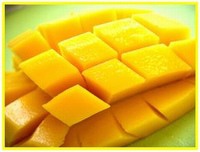 Mango (Mangifera indica L.) is one of the most important tropical fruit worldwide. It is appreciated for its functional and nutritional properties, and in the last years its consumption as a fresh-cut product has been increasing.
Mango (Mangifera indica L.) is one of the most important tropical fruit worldwide. It is appreciated for its functional and nutritional properties, and in the last years its consumption as a fresh-cut product has been increasing.Fresh-cut mango suffers from tissue browning and softening. The current conventional thermal treatments used by fresh-cut industry decrease the browning rate but accelerate the quality deterioration.
At the moment, the pulsed light technology is the most studied nonthermal method as an alternative to the conventional thermal treatments. In the food industry, the pulsed light treatment is already used to decontaminate surfaces, packaging or food (bread), however there is no data on its application for fresh produce.
French scientists have evaluated the impact of pulsed light technology on external appearance (firmness and color) and on nutritional quality (carotenoids, ascorbic acid, phenols, dry matter, PAL (Phenylalanineammonialyase) activity, PPO (Polyphenoloxydase) activity, proteins) in the fresh-cut mango ‘Kent’.
For the study, mangoes were peeled, diced, then the dices were washed in water with sodium hypochlorite, drained, treated by pulsed light, put in glass jar and stored at 6°C for 7 days. Cubes of mangoes were treated by 4 successive pulses, for a total fluence of 8 J/cm2 (one pulse has a total fluence of 2 J/cm2, light wavelength ranged from UV-C to IR)
The scientists found that the pulsed light treatment preserved the tissue firmness, color, and carotenoid content, but increased the PPO activity after 3 days of storage and maintained the PAL activity. As regards the nutritional quality, the pulsed light treatment preserved phenols and total ascorbic acid contents like the control treatment.
The scientists conclude that pulsed light technology can be used to preserve fresh-cut mango quality, however they underline: 1) the necessity of further studies on the effect of pulsed light on specific processes occurring in the fruit, and 2) the legislation on pulsed light technology should be improved, for example the European Union does not approve the pulsed light technology as such, but does approve specific food and food ingredients treated with pulsed light.
Source: Charles F., Vidal V., Olive F., Filgueiras H., Sallanon H., 'Pulsed light treatment as new method to maintain physical and nutritional quality of fresh-cut mangoes', 2013, Innovative Food Science and Emerging Technologies, Vol. 18, pagg. 190-195. Further info: http://www.sciencedirect.com/science/article/pii/S1466856413000337
